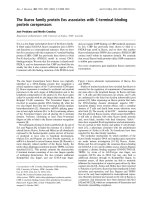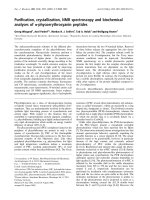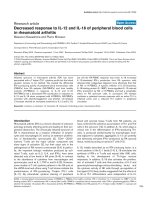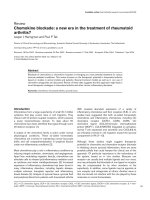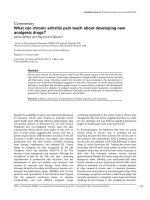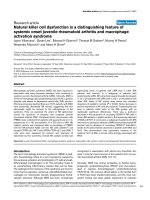Báo cáo y học: "Usurped SLRPs: novel arthritis biomarkers exposed by catabolism of small leucine-rich proteoglycans" pptx
Bạn đang xem bản rút gọn của tài liệu. Xem và tải ngay bản đầy đủ của tài liệu tại đây (36.17 KB, 2 trang )
Page 1 of 2
(page number not for citation purposes)
ADAMTS = a disintegrin and metalloproteinase with thrombospondin type I motifs; MMP = matrix metalloproteinase; OA = osteoarthritis; SLRP =
small leucine-rich proteoglycan.
Available online />Abstract
Proteolytic degradation of articular cartilage macromolecules,
including the large aggregating cartilage proteoglycan (aggrecan)
and small leucine-rich proteoglycans (SLRPs), is a prominent
pathophysiological feature of arthritic diseases such as osteo-
arthritis (OA). Molecular profiling and monitoring of soluble/
circulating proteoglycan catabolites that may be released from the
cartilage matrix therefore represents an attractive strategy for
evaluating OA disease progression and intervention. The recent
identification of discrete metalloproteinase-sensitive SLRP cleavage
sites, and complementary neoepitope-bearing SLRP catabolites,
extends decisive insight into the functional regulation of
extracellular matrix integrity, and proffers poignant leads to assist in
disclosing and appraising applicable biomarkers of cartilage
degeneration during arthritis.
Proficient operativity of articular cartilage is effectively
maintained via the specialized qualities of multiple macro-
molecular components, including a notable array of collagens
and proteoglycans. Critical attributes of collagen organization
and cytoregulatory sequelae are orchestrated in part through
the interactive influences of a number of small leucine-rich
proteoglycans (SLRPs), catabolism of which, for example
during osteoarthritis (OA), may thereby detrimentally alter the
biological and biophysical properties of the cartilage tissue.
New findings reported in Arthritis Research & Therapy by
Jordi Monfort and co-workers [1] provide an enhanced
awareness of such processes by identifying a specific matrix
metalloproteinase (MMP)-13 cleavage site in biglycan, and by
assessing the ability of MMP-13 to degrade a number of
SLRPs (biglycan, decorin, fibromodulin and lumican) present
in normal and OA human cartilage extracts. Related studies
also recently described in Arthritis Research & Therapy by
Allan Young and colleagues [2] further highlight the
susceptibility of cartilage SLRPs to proteolytic fragmentation
during active progression of OA, thus concomitantly
advocating the utility of monitoring SLRP catabolites as a
promising biomarker strategy for evaluating OA disease status.
Members of the SLRP gene family play vital roles in a variety
of tissues and extracellular matrices, comprising binding and
regulation of collagen fibrils, as well as modulation of cellular
responses [3]. As exemplified by knockout mice [4], SLRP
deficiencies in vivo lead to the development of corneal,
dermatological and musculoskeletal diseases (including OA),
indicating that the connate functions of SLRPs could be
profoundly impacted by post-translational (i.e. proteolytic)
processing events. Indeed, and with pertinent regard to this
tenet, cleavage of decorin by MMP-2, MMP-3 and MMP-7
can result in the release of sequestered transforming growth
factor-β, conceivably leading to pathological consequences
engendered by the soluble cytokine [5]. Decorin is
physiologically catabolized in human skin via hydrolysis of the
Phe170-Asn171 peptide bond located within the leucine-rich
region of the core protein, although in vitro cleavage of
decorin by MMP-3, or by ‘a disintegrin and metalloproteinase
with thrombospondin type I motifs-4’ (ADAMTS-4), occurs
amino-terminally distant at Glu154-Leu155 [6]. These
observations emphasize the importance of correlating
physiological processing events with those that can take
place using isolated proteins, and highlight a key aspect to
consider when designing assay reagents (i.e. antibodies) to
track neoepitope elucidation and dispersion. In the case of
fibromodulin, cleavage by MMP-13 between amino acid
residues Tyr63 and Ala64 yields specific neoepitope-bearing
fragments that are also detected in interleukin-1-stimulated
bovine articular cartilage explant cultures, suggesting that
such products may emanate in concert with joint disease
progression [7]. Interestingly, ADAMTS-4 is also capable of
Commentary
Usurped SLRPs: novel arthritis biomarkers exposed by
catabolism of small leucine-rich proteoglycans?
Carl R Flannery
Wyeth Research, Cambridge, MA, USA
Corresponding author: Carl R Flannery,
Published: 13 March 2006 Arthritis Research & Therapy 2006, 8:106 (doi:10.1186/ar1925)
This article is online at />© 2006 BioMed Central Ltd
See related research by Monfort et al. in issue 8.1 [
and Young et al. in issue 7.4 [ />Page 2 of 2
(page number not for citation purposes)
Arthritis Research & Therapy Vol 8 No 2 Flannery
cleaving fibromodulin at Tyr63-Ala64 [8], exemplifying the
possible contributions of disparate proteolytic activities in the
degradation of available substrates.
In their recently described work, Monfort and colleagues [1]
demonstrate that MMP-13 cleaves at Gly177-Val178 within
the leucine-rich region of biglycan, generating fragments
bearing the amino-terminal ‘neoepitope’ sequence 178VFSG ,
and revealing a practicable new signature ‘beacon’ of SLRP
catabolism. Recombinant MMP-13 was shown to degrade
biglycan and fibromodulin (and to a lesser extent decorin and
lumican) in cartilage extracts; however, it is important to
appreciate that the proteolytic susceptibilities of these
SLRPs may have become altered following their displace-
ment from the cartilage matrix. Intriguingly, an endogenous
biglycan degradation product similar in size to that generated
in vitro by MMP-13 was in fact present in some of the
cartilage specimens, although it remains to be definitively
confirmed whether this fragment is produced as a result of
cleavage at the MMP-13-sensitive Gly177-Val178 bond in
vivo. Such corroboration is amenable to expeditious
interrogation though the production and use of neoepitope
antibodies directed toward cryptic amino or carboxyl termini
exposed following proteolytic action, as have been
successfully applied for the detection of aggrecan and type II
collagen degradation products [9]. Furthermore, it will be
constructive to determine whether additional (metallo)-
proteinases (i.e. other MMPs or ADAMTSs) can also
contribute to the turnover of accessible cartilage SLRPs
through scission of either known or heretofore undiscerned
cleavage sites.
Conclusion
The availability and persistence of cartilage-derived SLRP
catabolites in synovial fluids and the peripheral circulation will
be essential parameters to validate in order to establish
efficacious assays for these potential biomarkers. Furthermore,
and with respect to previously expressed circumspection [10],
it is diligent to note that while proteolysis of SLRPs in articular
cartilage may yield tenable markers of arthritis pathology, it is
evident that SLRP degradation products (and indeed other
putative arthritis biomarkers) could be generated in joints other
than the index (affected) joint(s), and might in fact also
originate from diverse tissue sources, including skin,
intervertebral disc, meniscus and tendon [6,11-13]. Notwith-
standing these caveats, it will nonetheless be of substantial
interest to ascertain whether arthritis-associated alterations in
usurped SLRP fragments correlate with disease severity, and
to determine the contextual relationship of such levels within
the repertoire of realizable biomarkers of OA [14].
Competing interests
The author declares that they have no competing interests.
Acknowledgements
The author acknowledges receipt of funding/salary from Wyeth.
References
1. Monfort J, Tardif G, Reboul P, Mineau P, Mineau F, Roughley P,
Pelletier J-P, Martel-Pelletier J: Degradation of small leucine-
rich repeat proteoglycans by MMP-13: identification of a new
biglycan cleavage site. Arthritis Res Ther 2006, 8:R26.
2. Young AA, Smith MM, Smith SM, Cake MA, Ghosh P, Read RA,
Melrose J, Sonnabend DH, Roughley PJ, Little CB: Regional
assessment of articular cartilage gene expression and small
proteoglycan metabolism in an animal model of osteoarthri-
tis. Arthritis Res Ther 2005, 7:R852-R861.
3. Iozzo RV: The biology of the small leucine-rich proteoglycans.
J Biol Chem 1999, 274:18843-18846.
4. Ameye L, Young MF: Mice deficient in small leucine-rich pro-
teoglycans: novel in vivo models for osteoporosis,
osteoarthritis, Ehlers-Danlos syndrome, muscular dystrophy,
and corneal diseases. Glycobiology 2002, 12:107R-116R.
5. Imai K, Hiramatsu A, Fukushima D, Pierschbacher MD, Okada Y:
Degradation of decorin by matrix metalloproteinases: identifi-
cation of the cleavage sites, kinetic analyses and transform-
ing growth factor-beta1 release. Biochem J 1997, 322:
809-814.
6. Carrino DA, Onnerfjord P, Sandy JD, Cs-Szabo G, Scott PG,
Sorrell JM, Heinegard D, Caplan AI: Age-related changes in the
proteoglycans of human skin. Specific cleavage of decorin to
yield a major catabolic fragment in adult skin. J Biol Chem
2003, 278:17566-17572.
7. Heathfield TF, Onnerfjord P, Dahlberg L, Heinegard D: Cleavage
of fibromodulin in cartilage explants involves removal of the
N-terminal tyrosine sulfate-rich region by proteolysis at a site
that is sensitive to matrix metalloproteinase-13. J Biol Chem
2004, 279:6286-6295.
8. Kashiwagi M, Enghild JJ, Gendron C, Hughes C, Caterson B, Itoh
Y, Nagase H: Altered proteolytic activities of ADAMTS-4
expressed by C-terminal processing. J Biol Chem 2004, 279:
10109-10119.
9. Fosang AJ, Stanton H, Little CB, Atley LM: Neoepitopes as bio-
markers of cartilage catabolism. Inflamm Res 2003, 52:277-
282.
10. Brandt KD: A pessimistic view of serologic markers for diag-
nosis and management of osteoarthritis. Biochemical,
immunologic and clinicopathologic barriers. J Rheum 1989,
16(Suppl 18):39-42.
11. Roughley PJ, White RJ, Mort JS: Presence of pro-forms of
decorin and biglycan in human articular cartilage. Biochem J
1996, 318:779-784.
12. Sztrolovics R, Alini M, Mort JS, Roughley PJ: Age-related
changes in fibromodulin and lumican in human intervertebral
discs. Spine 1999, 24:1765-1771.
13. Rees SG, Flannery CR, Little CB, Hughes CE, Caterson B, Dent
CM: Catabolism of aggrecan, decorin and biglycan in tendon.
Biochem J 2000, 350:181-188.
14. Kraus VB: Biomarkers in osteoarthritis. Curr Opin Rheumatol
2005, 17:641-646.
